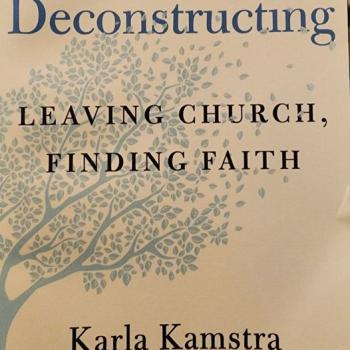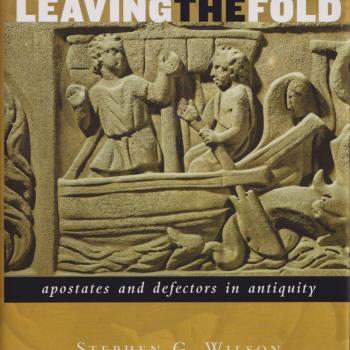
The first several articles in this column focused on the history of conversion research. Understanding how religious conversion works is important to understanding how deconversion works. But it has come time to dig into the features of deconversion.
Deconversion research is still in its infancy in comparison to conversion research. And so the first task of the researcher is to define what “deconversion” means. The leading figure in deconversion research is currently Dr. John Marriott. In his book The Anatomy of Deconversion he says, “the term deconversion refers to the rejection of Christian beliefs, disengagement from a Christian community, and having no religious affiliation.”
This casts a broader net than one might think. The first volume of the Atheism and Secularity compendium throws out dozens of terms to refer to individuals not associating with religion, including “secular, irreligious, nonreligious, and antireligious.” Each of these terms has its own subtle distinction from every other, even if they all share the common feature of not being religious. One might add to this list the terms “agnostic,” and “apatheist,” which mean “don’t know” and “don’t care” respectively. The Pew Report Survey offers four options for those who do not associate with religion: atheist, agnostic, spiritual-but-not-religious, and the infamous “none.”
As of this writing, the box that is getting checked more and more frequently on these forms is “none.”
Surely there exists some level of nuance between a person who exits their religious circle, sheds their religious beliefs, and then checks the “none” box, versus the person who checks the “atheist” box. Atheism, after all, makes certain definite statements about the nature of religion and the approach to God. “None” is a failure to commit to any position, and stays out of the religion game entirely – including attempts to discredit or debunk religion.
For Dr. Marriott, it matters not which category or label the person lands upon once they exit their religious tradition, just that the exit occurs. For this writer, however, an important distinction must be made.
Labels for the Non-religious
Many years ago, when Christianity was the social norm and Communism was preceded by the adjective “Godless,” people exited or failed to enter religious traditions, but only a fringe of the population would go so far as to adopt the term “atheist.” It was a bold and aggressive stance to take, and would require some justification from society at large. In most cases, these religious exiters would remain “cultural” or “nominal” Christians, or they would back out of the religion game entirely and assert that it “just isn’t my thing.” The church tended to differentiate between those who left religion and denied God, versus those who quietly backed out of the church never to return. The former were “apostates”, and the latter were “backsliders.” Generally, the Church assumed that apostates were probably never religious to begin with, whereas backsliders were still “saved” but needed to get back on track with God.
In modern days, this distinction still exists. There are those who exit the church never to return, but do not immediately open a YouTube channel to rail against the evils of religion, write blogs condemning the Evangelical Right, or publish e-books debunking God. In fact, some of these people might still admit that there is probably some kind of spiritual force out there, and may even retain the moral notions and political ideas they held when attending church. However it isn’t of interest to them, and they prefer to stay out of the God game entirely.
And then there is the strikingly expanding subculture of the irreligious – meaning those who take firm stances in opposition to religion and the idea of God or the supernatural. There are a seemingly endless litany of labels adopted by this irreligious subculture, but for the purposes of deconversion research, we are primarily interested in whether the person leaves the religion game entirely, or takes an aggressively anti-religious stance. Because presumably there are different processes by which the two individuals exit their churches.
For the purposes of this column, “deconversion” refers to the process by which one goes from identifying as “Christian,” and lands on identifying as “atheist” or some similar anti-religious label. For those who end up in the “None” column, we will use the term “disaffiliation.”
Disaffiliation
William James spoke of religious conversion as a shift of emphasis in identity. His illustration was this: Let’s say a president goes out camping. He discards the suit, the office, the political rhetoric, and puts on outdoorsman clothes and lingo. Suddenly what you’re seeing is an outdoorsman, not a president. Same guy, and the president is still in there, but he’s shifted his behavior to emphasize a different set of characteristics. This is a good illustration for Disaffiliation. Imagine a guy who goes to church on Sunday, hangs out with work buddies during the week talking about their favorite Netflix series, goes online and argues about politics, and then plays sports on Saturdays. Most people are like this: they have a range of interests and a variety of social groups. Under Disaffiliation, other interests begin to rise in priority for the person and religion becomes less of a priority. The person gradually shifts their identity to favor other interests over religion until religious interests are entirely discarded.
Once religious interests are discarded, the person may or may not experience a change in personal values. They may or may not begin to find religion distasteful. But one thing separates them from a deconvert: their identity no longer has any relationship with religion. Atheism is a stance which remains in relationship to religion, even if that relationship is defined by its opposition to religion. There is still a great deal more commitment when checking the “Atheist” box than there is the “None” box.
Deconversion
As discussed in the previous section, disaffiliates generally consider their religion as one facet of a number of competing interests. Deconverts, on the other hand, are almost always strongly committed to their religious identity. Religion forms the core of their self-image such that stepping away from religion generates an identity crisis. The resolution to this crisis is to adopt an identity which stands in opposition to his or her previous identity as a Christian.
One possible exception to this involves individuals who have suffered abuse within their religious context. The radical separation from the church is not in response to an identity crisis so much as it is hostility toward the community he or she sees as responsible for his or her abuse.
Conclusion
For the purposes of this column, when talking about “deconversion” we are talking about individuals who once reported their identity as “Christian” but began, at some point, to report their identity as some flavor of anti-religious, be that atheist, agnostic, skeptic, free thinker, or similar labels.
This column will primarily focus on deconverts rather than disaffiliates.













